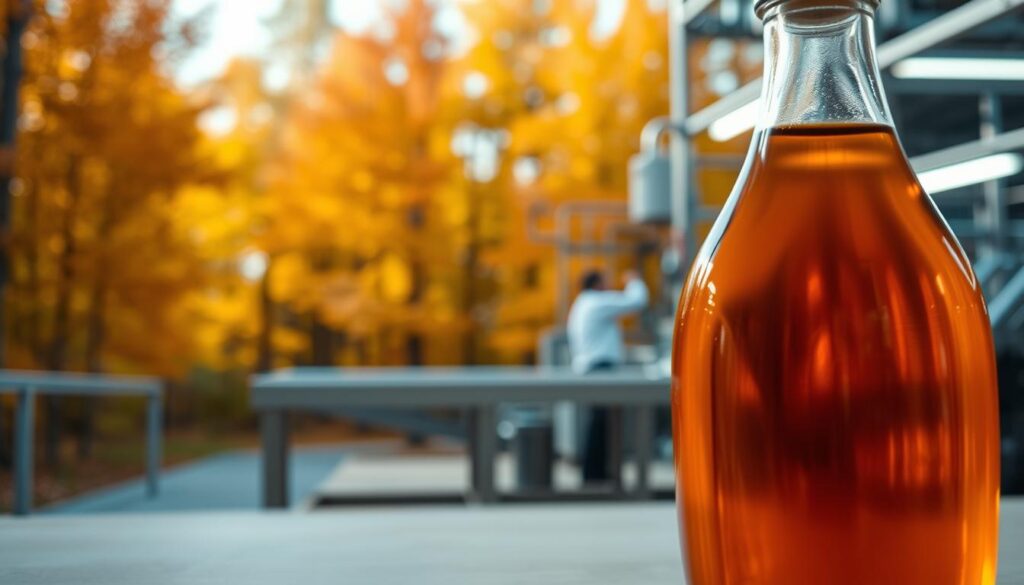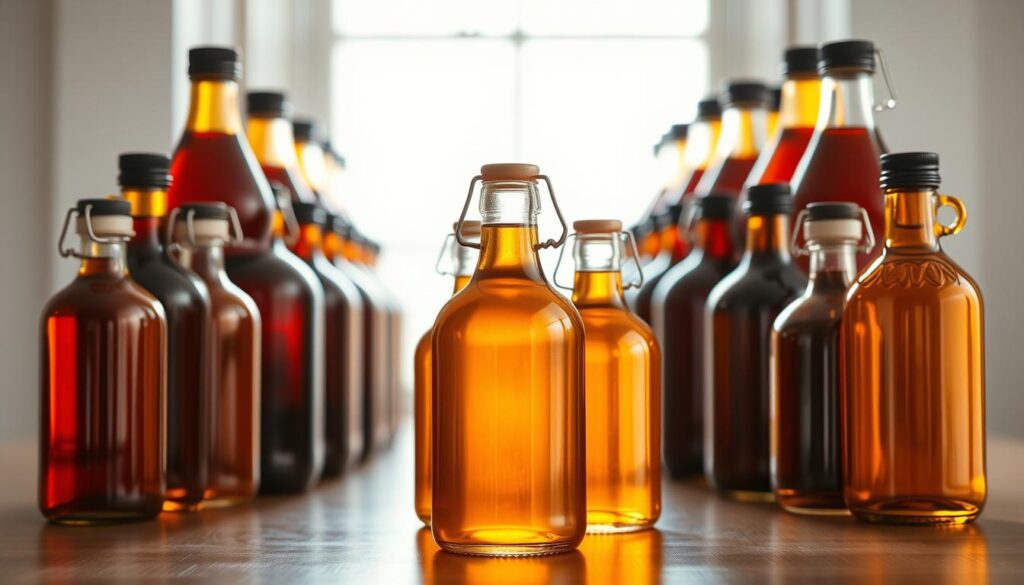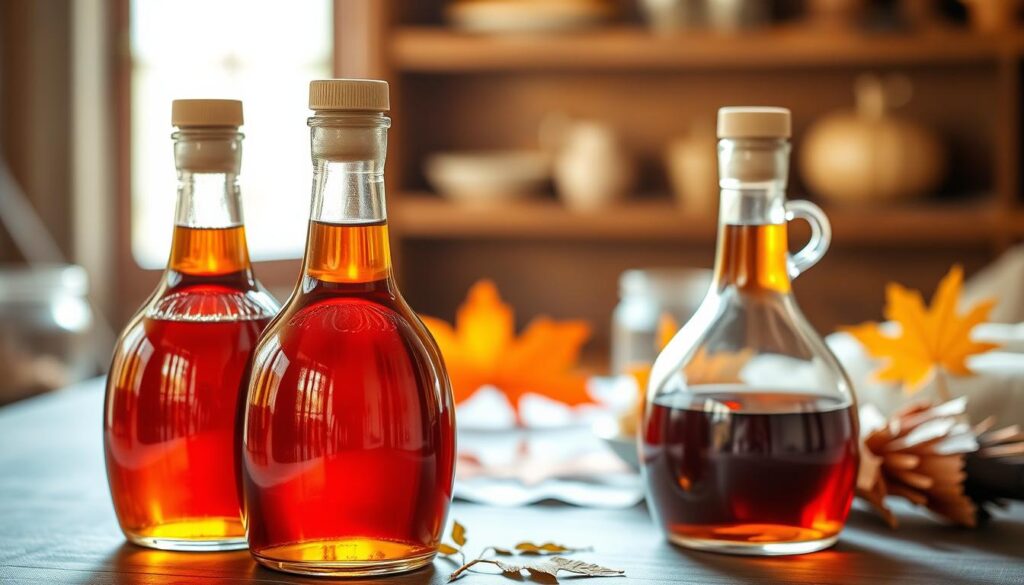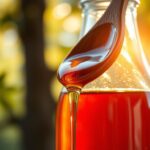Maple syrup lovers know how important good storage is. It keeps the syrup’s flavor and quality just right. Glass containers are the best for keeping maple syrup’s special taste.
Maple syrup’s journey from the forest to your table is long. It starts with careful collection and ends with expert packaging. Maple syrup bottles are more than just storage. They protect the syrup’s unique taste from outside influences.
Glass containers have benefits that other materials can’t match. Their non-reactive surface keeps the syrup’s flavor pure. This gives you a true taste of maple trees.
Professional sugarmakers pick their bottles with care. The right glass container does more than store syrup. It shows off craftsmanship, tradition, and detail from North America’s maple forests.
Every bottle is a mix of preservation and presentation. You can find bottles from 250ml for home use to larger sizes for businesses. Maple syrup bottles come in many shapes and sizes to fit different needs.
Finding the right glass container is an art. Sugarmakers look for a bottle that protects their syrup and looks good. This makes maple syrup a beautiful addition to any kitchen.
Exploring maple syrup packaging shows the care producers put into it. It’s a journey that shows how much they value this natural sweetener.
The History of Maple Syrup Packaging Evolution
Maple syrup packaging has changed a lot over time. It started with ancient ways and now uses modern glass containers. This shows how culture and technology have both played a part.
Early Storage Methods and Traditional Containers
Native American communities were the first to figure out how to keep maple syrup. They used:
- Birch bark containers for collecting and storing maple sap
- Wooden hollowed-out logs for boiling and reducing syrup
- Clay vessels for short-term storage
These methods were very smart. They used what was available in nature.
The Transition to Glass Bottles
Glass bottles changed maple syrup packaging in the late 1800s. They found glass was better because it:
- Kept the syrup’s flavor better
- Was more durable than before
- Looked nicer to customers
Modern Packaging Innovations
Today, maple syrup packaging goes beyond glass. Makers are trying out new, green ways to package syrup. These new methods keep the syrup good while being kind to the planet.
Now, packaging focuses on:
- Keeping the syrup safe to eat
- Being good for the environment
- Keeping the syrup’s nutrients
“Packaging is not just about containment, but about preserving the essence of maple syrup’s rich heritage.” – Maple Syrup Artisan
Why Glass Containers Are Ideal for Maple Syrup Storage
Glass containers are the best for keeping maple syrup fresh. They protect the syrup’s flavor and quality. Glass is perfect for storing maple syrup because it keeps it safe and looks great.
Using glass for maple syrup storage has many benefits. Here are the main reasons:
- Complete flavor preservation
- Chemical inertness preventing contamination
- 100% transparency for visual inspection
- Superior protection from light and air exposure
Maple syrup makers choose glass because it keeps the syrup’s taste pure. Unlike plastic or metal, glass doesn’t mix with the syrup chemically. This means the syrup tastes just as good from start to finish.
| Container Material | Flavor Preservation | Chemical Interaction |
|---|---|---|
| Glass | Excellent | None |
| Plastic | Good | Potential |
| Metal | Fair | High |
Glass containers are also good for the planet. They can be recycled or reused. This makes them a green choice for both producers and buyers.
Glass containers aren’t just storage—they’re a commitment to preserving maple syrup’s natural excellence.
Essential Features of Quality Maple Syrup Bottles
Choosing the right Maple Syrup Bottles is important. You need to think about many things to keep the syrup good. The right bottle is key to keeping the syrup’s flavor and nutrients.
Closure Systems and Sealing Methods
Good Maple Syrup Bottle Design needs strong closure systems. These systems keep the syrup fresh and clean. Producers use special sealing methods:
- Tamper-evident screw caps
- Vacuum-sealed lids
- Airtight plastic stoppers
Material Grade Requirements
Glass bottles must be food-grade. Manufacturers choose high-quality borosilicate glass. This glass keeps the syrup’s temperature steady and prevents chemical reactions.
Design Considerations for Preservation
Top Maple Syrup Bottles have special designs. These designs help keep the syrup quality high:
- Dark-tinted glass to block harmful UV rays
- Wide-necked bottles for easy pouring
- Ergonomic shapes that minimize syrup exposure to air
“A great maple syrup bottle is more than a container—it’s a guardian of flavor.”
Popular Maple Syrup Bottle Shapes and Designs

Maple syrup bottles have changed from simple containers to works of art. The design of these bottles is key in drawing in customers and keeping the syrup fresh. Sugarmakers pick bottle shapes that look good and work well.
Traditional Maple Syrup Bottles often have special designs that show off maple syrup making. Some popular designs include:
- Classic maple leaf-shaped containers
- Rounded glass bottles with wide mouths
- Sleek, minimalist rectangular designs
- Vintage-inspired amber glass containers
Modern maple syrup bottle design focuses on a few key things. Functionality meets creativity in today’s packaging. The best bottles are easy to pour from and look good, showing off the craft that goes into making maple syrup.
The right bottle design can transform maple syrup from a simple condiment to a premium culinary experience.
When picking maple syrup bottle designs, producers think about a few things. They look at how well the bottle stores the syrup, how well it shows off the brand, and how easy it is for customers to use. Some small producers choose unique, handmade bottles that show off the traditional way of making maple syrup. On the other hand, bigger producers go for standard designs that make production and shipping easier.
- Size ranges from 3 oz sampler bottles to 1-gallon containers
- Glass remains the preferred material for maple syrup packaging
- Custom shapes help brands differentiate themselves
The art of Maple Syrup Bottle Design keeps getting better, mixing old ways with new ideas. This creates packaging that really shows off the beauty of this natural sweetener.
Maple Syrup Bottles: Size Options and Commercial Standards
Maple syrup production needs the right bottle sizes for different needs. Knowing the sizes helps both makers and buyers pick the best packaging.
Retail Packaging Sizes
Maple syrup bottles come in many sizes to fit what people like. Common sizes for sale include:
- 1 fluid ounce (sample size)
- 3.4 fluid ounces (mini bottle)
- 8.5 fluid ounces (standard size)
- 12.7 fluid ounces (pint)
- 32 fluid ounces (quart)
Bulk Storage Solutions
For big needs, maple syrup makers use bigger containers. They use:
| Container Type | Volume | Primary Use |
|---|---|---|
| Bulk Containers | 1-5 gallons | Restaurant Supply |
| Commercial Drums | 50-55 gallons | Large-Scale Distribution |
Industry Standard Measurements
Maple syrup bottles follow strict rules. Producers measure and label them to show accurate volume. They use fluid ounces and milliliters, following food packaging rules.
Environmental Impact of Glass Maple Syrup Containers

Glass maple syrup containers have a complex story. They face ecological challenges but offer sustainable solutions. Making these containers uses a lot of energy. But, their long-term benefits are worth it.
The environmental impact of glass packaging is big. It includes:
- Energy-intensive manufacturing processes
- High recyclability
- Less single-use plastic waste
- Potential for many reuse cycles
The maple syrup industry is working hard to cut down on carbon. They’re finding new ways to reduce environmental harm without losing quality.
Here are the main benefits of glass containers:
- Zero chemical leaching compared to plastic
- 100% recyclable
- Keeps products fresh longer
- Less microplastic pollution
While making glass needs a lot of energy, it can be recycled endlessly. New glass-making methods are also using less energy and harming the environment less.
Sustainable packaging is not just about the material, but about the entire lifecycle of the container.
Recycling programs and local glass recovery efforts are changing things. They turn Glass Maple Syrup Containers into valuable resources. This shows the industry’s dedication to protecting the environment.
Professional Labeling and Branding Requirements
Maple syrup branding is more than just packaging. It tells the story, quality, and heritage of the syrup. It connects consumers to the traditional maple production process. Good labeling is key for both producers and consumers.
Creating a strong maple syrup brand needs a smart approach to visuals and following rules. Producers face many guidelines while making their products stand out.
Legal Compliance Guidelines
Maple syrup labels must follow strict federal and state rules. Important rules include:
- Clear product classification
- Accurate volume measurements
- Nutritional information display
- Origin and grade specification
Marketing Best Practices
Innovative branding turns packaging into a marketing powerhouse. The design shows the syrup’s quality and the brand’s story.
| Branding Element | Marketing Impact |
|---|---|
| Color Scheme | Evokes maple forest imagery |
| Typography | Communicates artisan quality |
| Label Materials | Suggests premium positioning |
Authentic labeling for maple syrup balances rules with creative stories. Successful brands make packaging an emotional connection with consumers.
Storage and Handling Guidelines for Glass Syrup Containers

Storing Maple Syrup Bottles right is key to keeping their quality and taste. Glass containers need special care to keep their contents fresh and safe from contamination.
Temperature is very important for keeping maple syrup good. Sugarmakers say to store these containers in cool, dark places. This helps avoid flavor loss and spoilage.
- Keep maple syrup bottles away from direct sunlight
- Store at consistent temperatures between 40-50°F
- Avoid temperature fluctuations that can impact syrup quality
When you handle Glass Maple Syrup Containers, there are important steps to follow:
- Always use clean utensils when pouring syrup
- Seal containers tightly after each use
- Check for any signs of crystallization or mold
| Storage Location | Recommended Duration | Temperature Range |
|---|---|---|
| Pantry (Unopened) | 1 Year | 50-70°F |
| Refrigerator (Opened) | 6 Months | 33-40°F |
| Freezer | Indefinite | 0°F or Below |
Professional tip: Always inspect maple syrup bottles before use, and discard any containers showing signs of contamination or unusual changes in color or consistency.
Cost Analysis: Glass vs. Alternative Packaging Materials
Choosing the right packaging for maple syrup is key. It affects both short-term costs and long-term value for producers.
For sustainable maple syrup bottling, producers need a smart packaging plan. They must consider many factors when picking container materials.
Initial Investment Considerations
Glass bottles cost more upfront than other options. Here’s a breakdown of production costs:
| Packaging Material | Initial Cost per Unit | Durability Rating |
|---|---|---|
| Glass Bottles | $0.50 – $1.25 | High |
| Plastic Containers | $0.25 – $0.75 | Medium |
| Metal Containers | $0.40 – $1.00 | High |
Long-term Economic Benefits
Even with higher costs, glass packaging has big pluses:
- It keeps the product fresh longer
- It makes your brand look better
- It’s recyclable and eco-friendly
- It saves money in the long run
Investing in quality glass containers can pay off for maple syrup producers. The right packaging mix balances upfront costs with long-term gains.
Innovative Bottle Designs for Maple Syrup Products
The world of maple syrup packaging is now filled with creative designs and practical solutions. Maple Syrup Bottle Design has moved beyond simple glass containers. It now includes innovative ideas that are both fun and useful.
Today, maple syrup makers are coming up with new ways to package their products. They are using:
- Ergonomic squeeze bottles with precision pour spouts
- Compact travel-sized containers for outdoor enthusiasts
- Transparent gradient glass bottles showing syrup color changes
- Interactive packaging with temperature-sensitive labels
These new designs do more than just protect the syrup. They also tell the brand’s story and engage customers. Sustainability meets creativity in these designs, focusing on looks and the environment.
Artisan maple syrup makers are using special bottle shapes that show off their region’s heritage. They have everything from hexagonal bottles that look like honeycombs to sleek, modern designs with simple labels. These changes are changing how people see and use maple syrup products.
“Design is not just what it looks like and feels like. Design is how it works.” – Steve Jobs
The future of maple syrup packaging will mix useful innovation with visual stories. It aims to create lasting memories for customers while keeping the syrup’s quality and tradition.
Safety Considerations for Maple Syrup Packaging
Maple syrup production needs careful attention to safety during packaging. Glass bottles are key to keeping syrup safe and healthy for consumers. Producers must follow strict safety rules to ensure syrup is delivered in top condition.
Keeping maple syrup safe involves more than just putting it in a bottle. Producers must follow strict guidelines to protect both the syrup and the people who buy it.
Food Grade Requirements
Maple syrup packaging must meet high food safety standards. Important rules include:
- Certified food-grade glass materials
- Non-reactive container surfaces
- Transparent containers for visual inspection
- Smooth interior surfaces preventing bacterial growth
Transportation Safety Measures
Shipping maple syrup bottles safely requires smart packaging:
- Cushioned protective packaging
- Temperature-controlled transportation
- Shock-absorbent shipping containers
- Tamper-evident sealing mechanisms
| Safety Aspect | Recommended Practice | Purpose |
|---|---|---|
| Glass Quality | Borosilicate Glass | Chemical Resistance |
| Seal Integrity | Vacuum-sealed Caps | Prevent Contamination |
| Storage | Dark, Cool Environment | Preserve Nutritional Quality |
Professional maple syrup producers know safety starts with the right packaging. It continues with careful handling and shipping.
Custom Bottle Solutions for Maple Syrup Producers
Maple syrup producers are finding out how important unique Maple Syrup Bottle Design is. It’s a key marketing strategy. Custom bottles help them stand out in a crowded market.
Creating a unique Maple Syrup Branding starts with custom packaging. Small and medium producers can use special bottle designs. These designs make their brand unforgettable to customers.
- Personalized shape and contour selections
- Custom label artwork integration
- Specialized glass or material choices
- Unique closure mechanisms
Choosing custom bottles needs careful thought. Producers must think about looks and practical things like:
- Minimum order quantities
- Production costs
- Manufacturing complexity
- Packaging durability
Good bottle design can make maple syrup seem like a luxury. Innovative packaging tells a story. It shows heritage, skill, and quality before you even taste it.
Custom packaging is not an expense, but an investment in brand recognition and consumer loyalty.
Maintaining Product Quality Through Proper Bottling
Maple syrup production needs careful attention in the bottling stage to keep its quality and flavor. Sustainable bottling of maple syrup means paying close attention to every detail. This ensures the syrup stays natural from start to finish.
The bottling process has key steps to keep the syrup’s quality:
- Temperature control during filling
- Preventing air bubble formation
- Implementing rigorous quality checks
- Using sterile glass containers
Producers use special techniques to keep the syrup quality high. Hot filling is a common method. It involves filling the syrup at 180-190°F. This method stops bacteria and seals the glass bottles well.
Quality control is vital in sustainable bottling. Sugarmakers check each bottle visually and use machines to test them. These steps catch any problems before the syrup is sold.
Proper bottling is the final guardian of maple syrup’s delicate flavor and purity.
Choosing the right glass containers is key in making maple syrup. Clear, food-grade glass bottles with tight lids keep the syrup fresh. They stop air from getting in and keep the syrup’s taste.
- Minimize oxygen exposure
- Use clean, sterilized equipment
- Maintain consistent bottling temperatures
By using these advanced bottling methods, maple syrup makers ensure their product is top-notch. It captures the true spirit of maple syrup making.
Conclusion
Glass maple syrup bottles blend old traditions with new packaging tech. They’ve changed how we store, protect, and show off maple syrup. From wooden buckets to glass containers, packaging has seen big changes.
The story of maple syrup bottles shows both cultural roots and tech progress. Today’s glass containers keep syrup’s flavors and nutrients safe. Producers pick packaging that looks good and works well, showing off their work.
The future of maple syrup bottles looks bright. New tech will make bottles more eco-friendly, efficient, and pretty. These changes will keep syrup fresh, cut down on waste, and meet what customers want.
As people care more about where their food comes from, maple syrup bottles will keep getting better. The right bottle is about more than just keeping syrup safe. It’s about keeping a tradition alive and giving a great taste experience with every bottle.



